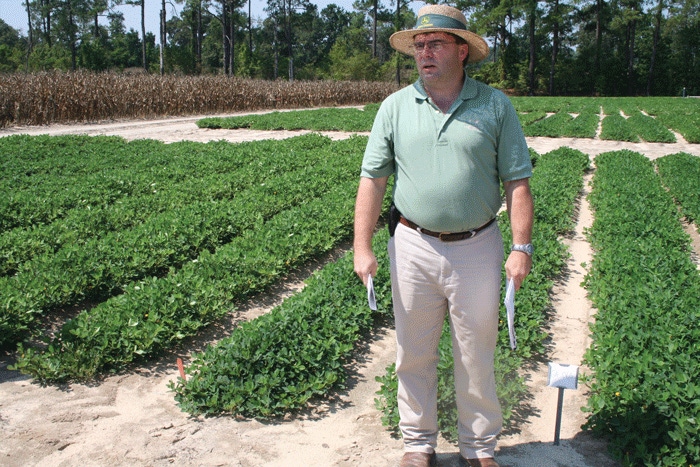August 6, 2012

South Carolina peanut growers planted a record number of acres this spring and North Carolina growers upped acreage significantly enough to stay ahead of their neighbors to the South.
The extra acres didn’t come without some struggles and enough delays to lead some to wonder what impact late planting may have on total yield and quality.
Although the majority of the Carolina peanut crop is doing well so far, growers are still having germination/stand problems with a few of the late planted runner varieties. Some growers were able to replant while others either could not get seed or ran out of time.
Estimates are that more than 95 percent of peanuts were planted by June 8 in the Carolinas. If so, yield expectations of 3,400 to 3,600 pounds per acre are possible.
However, it’s hard to know how many acres of peanuts suffered stand losses from cool, wet and cloudy conditions during prime time for planting and how many of these acres were replanted late.
In the southern end of the Carolina peanut belt many growers were delayed planting by as much as a month because of a lack of moisture.
Luray, S.C., peanut and cotton grower Bud Bowers says 2012 was one of his most frustrating planting seasons because of the lack of moisture. Despite having about half his crop under irrigation, the veteran South Carolina grower says he still got behind on both crops and planted later than he planned.
Early July was not ideal for peanut production in the Carolinas. In North Carolina, as of July 1, 55 percent of North Carolina fields were rated as short or very short of moisture. By the first week of July crops in many areas of the state were beginning to show heat stress, according to reports from the North Carolina Crops and Weather Report.
By mid-July, many crops were in moderate to severe drought stress throughout the Virginia-Carolina belt.
Whether or not seeding problems will significantly impact planted acres remains to be seen.
As of April planting time, grower’s intentions surveys indicated South Carolina may push 100,000 acres of peanuts this year — a state record and pushing the Palmetto state close to the acreage planted in North Carolina.
South Carolina Peanut Specialist Scott Monfort says this year’s peanut crop in South Carolina had one of the longest planting seasons ever.
Variable planting conditions
Drought in the southern end of South Carolina’s peanut belt and excessive moisture in the northern end of the belt created planting problems of different kinds, but led to an extended planting season that ran from mid-April until mid-June.
The same conditions that delayed or played havoc with activation of herbicides also caused early season weed control and delayed gypsum application on many acres of Virginia type peanuts in the region.
“Fortunately, Mother Nature came through for growers and allowed most of them to get back in the field and slowly catch up,” Monfort says.
Especially in South Carolina, there was no uniformity in planting dates because weather conditions varied so greatly from the south end to the north end of the peanut belt.
Regardless of when peanuts were planted, the challenge will be to keep the crop well managed until harvest time, and then to get peanuts out of the ground quickly and efficiently.
One factor to remember on late-planted, large kernel peanuts is to be sure inoculants worked properly. Monfort says at 45-60 days after planting a grower can determine whether he has an inoculant failure.
An average of 15 large nodules per taproot at 45-60 days after planting is considered good. Less than 10 per taproot is marginal and less than five indicates poor inoculation.
North Carolina State University Peanut Specialist David Jordan says there have been plenty of questions this season about how much yield will be lost when peanuts are planted later than usual.
Jordan says, “Peanuts planted in early May versus late May essentially yield the same if they are taken care of and dug based on optimum maturity (3,869 vs. 3,836 pounds per acre, respectively). These data are from three years of tests at Lewiston, N.C., with the varieties Champs (early maturing) and Perry (late maturing),” Jordan adds.
However, Jordan says for growers forced to plant peanuts later than they planned, there is a risk of significant yield reduction.
In the same tests conducted at the North Carolina Peanut Belt Research Station in Lewiston, Jordan says there was a big drop in yield from May 22, to June 8 (3,836 vs. 2,992 pounds per acre).
Weed control issues
Weed control is always an issue with peanuts because it doesn’t compete aggressively with several common weed species in the Southeast. Delayed planting can put weed control out-of-synch with spraying for other crops and create some problems in keeping peanuts clean from planting to digging.
Recent research in Virginia indicates yield losses to horsenettle can range from 15-20 percent. Losses to this particular weed may become even more important to peanut growers because horsenettle has shown resistance to a wide range of herbicides, including glyphosate.
Lack of moisture in some areas of the V-C Belt created problems with activation of pre-plant herbicides used to replace glyphosate and to help manage horsenettle.
Common lambsquarters has likewise shown some resistance to glyphosate, especially in the northern third of the Carolina-Virginia peanut belt. Losses of up to 40 percent in heavily infested and poorly managed fields have been documented.
Despite the publicity over the loss of yield to pigweed, the potential risk to this commonly occurring weed in peanuts is less than half that of cocklebur. It was managed routinely as a side benefit to using a wide range of herbicides that go back to the days of using Dyanap and a wide range of so called ‘yellow herbicides.’
While cocklebur is much easier to manage than pigweed, it can be devastating in fields in which it is allowed to compete with peanuts for moisture and nutrition.
Generally, keeping peanuts weed free for 6-10 weeks after planting significantly lowers the risk of yield loss to weeds. However, planting later than recommended, certainly past the first week or two of June puts growers at a heightened risk for all weeds.
Late planted peanuts have the extra risk of competing with weeds in hotter, dryer conditions than May-planted peanuts.
Not only does yield loss occur from competition with weeds, but late-occurring weeds commonly interfere with digging. Harvest time losses in yield and in peanut quality can combine to create significant economic losses with late planted peanuts.
Heat and drought throughout most parts of the Carolina-Virginia belt in July will likely intensify problems growers will have with late planted peanuts at harvest time.
Despite the long planting season and ongoing mid-season problems with heat and drought, peanuts planted on time appear to be on course for an average to good yield and quality year.
About the Author(s)
You May Also Like






